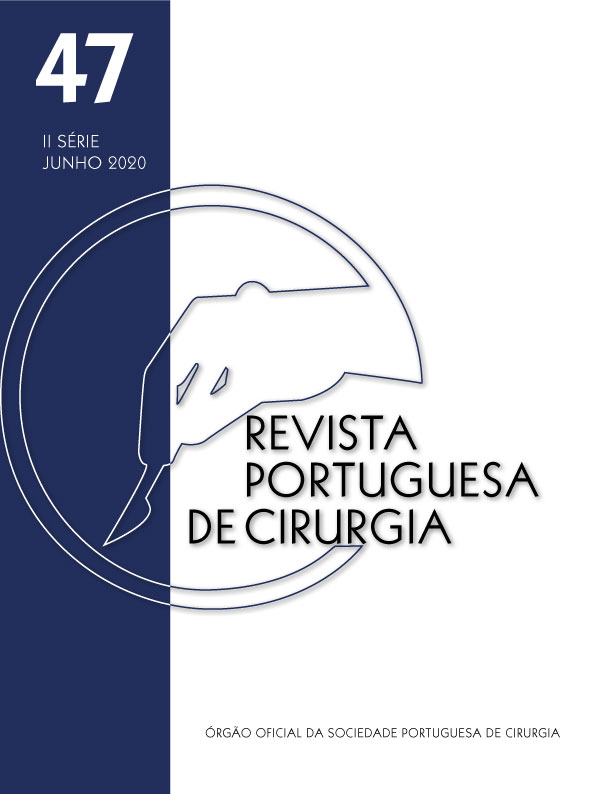TOTALLY IMPLANTABLE VENOUS ACCESS DEVICES IN ONCOLOGY: RETROSPECTIVE ANALYSIS OF 652 PATIENTS
DOI:
https://doi.org/10.34635/rpc.726Keywords:
Totally implantable catheters, Neoplasms, ChemotherapyAbstract
Introduction: Adequate venous access is essential for the treatment and management of cancer patients. Insertion of totally implantable venous access devices (TIVADs) provide a safe method for chemotherapy (ChT) administration, but it’s not free of complications. We aim to analyze our institution clinical practice experience regarding TIVADs.
Materials and Methods: Electronic medical records (EMR) review of all cancer patients that required placement of a TIVAD at Hospital da Luz between January 1st 2008 and December 31st 2014.
Results: Clinical data from 652 cancer patients was retrospectively reviewed. The overall incidence of complications was 14.1% (91), with only 6 (0.9%) being early complications (before the first clinical TIVAD utilization). The most common complications were thrombosis (30, 4.5%) and infections (TIVAD related and cutaneous, 24, 3.5%), followed by exteriorization (13, 1.9%) and catheter dysfunction (11,1.6%). 155 TIVADs were removed, the majority (95, 61.3%) because of end of treatment and the remainder (60; 38.7%) due to catheter complications.
Discussion: Global complication rate was as expected, however we observed a low rate of early complications, and we didn’t observe any potentially fatal complication related to the procedure. Unlike expected, thrombotic complications were the most frequent, followed by infectious complications.
Conclusions: TIVADs insertion is a safe procedure in cancer patients with an apparent low rate of complications with no fatal events identified in this study.
Downloads
References
2. Granic M, Zdravkovic D, Krstajic S, et al.: Totally implantable central venous catheters of the port-a-cath type: complications due to its use in the treatment of cancer patients. JBUON 2014; 19: 842-846.
3. Granziera E, Scarpa M, Ciccarese A, et al.: Totally implantable venous access devices: retrospective analysis of different insertion techniques and predictors of complications in 796 devices implanted in a single institution. BMC Surgery 2014;14:27.
4. An H, Ryu CG, Jung EJ, et al.: Insertion of Totally Implantable Central Venous Access Devices by Surgeons. Ann Coloproctol 2015; 31:63-67.
5. Niederhuber JE, Ensminger W, Gyves JW, et al.: Totally implanted venous and arterial access system to replace external catheters in cancer treatment. Surgery 1982; 92:706–712.
6. Schiffer CA, Mangu PB, Wade JC, et al.: Central Venous Catheter Care for the Patient With Cancer: American Society of Clinical Oncology Clinical Practice Guideline. J Clin Oncol 2013; 31:1357-1370
7. Gurkan S, Seber S, Gur O, et al.: Retrospective evaluation of totally implantable venous access port devices: Early and late complications. JBUON 2015; 20: 338-345.
8. Barbetakis N, Asteriou C, Kleontas A, et al.: Totally Implantable Central Venous Access Ports. Analysis of 700 Cases. Journal of Surgical Oncology 2011; 104:654–656.
9. Delluc A, Le Gal G, Scarvelis D, et al.: Outcome of central venous catheter associated upper extremity deep vein thrombosis in cancer patients. Thrombosis Research 2015; 135 298–302
10. National Comprehensive Cancer Network. Cancer-Associated Venous Thromboembolic Disease. Version 1.2016. https://www.nccn.org/professionals/physician_gls/pdf/vte.pdf. Accessed December 2017.
11. Oliveira E, Reis MA, Avelar TM, et al.: Totally implantable central venous catheters for chemotherapy: experience with 793 patients. Rev. Col. Bras. Cir. 2013; 40: 186-190.
Downloads
Published
Issue
Section
License
Para permitir ao editor a disseminação do trabalho do(s) autor(es) na sua máxima extensão, o(s) autor(es) deverá(ão) assinar uma Declaração de Cedência dos Direitos de Propriedade (Copyright). O acordo de transferência, (Transfer Agreement), transfere a propriedade do artigo do(s) autor(es) para a Sociedade Portuguesa de Cirurgia.
Se o artigo contiver extractos (incluindo ilustrações) de, ou for baseado no todo ou em parte em outros trabalhos com copyright (incluindo, para evitar dúvidas, material de fontes online ou de intranet), o(s) autor(es) tem(êm) de obter, dos proprietários dos respectivos copyrights, autorização escrita para reprodução desses extractos do(s) artigo(s) em todos os territórios e edições e em todos os meios de expressão e línguas. Todas os formulários de autorização devem ser fornecidos aos editores quando da entrega do artigo.



